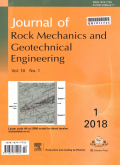- 钛学术文献服务平台 \
- 学术期刊 \
- 基础科学期刊 \
- 天文学、地球科学期刊 \
- 岩石力学与岩土工程学报(英文版)期刊 \
Bearing capacity of surface circular footings on granular material under low gravity fields
Bearing capacity of surface circular footings on granular material under low gravity fields
基本信息来源于合作网站,原文需代理用户跳转至来源网站获取
摘要:
Low gravity fields have been simulated through magnetic acceleration to conduct experimental study on bearing capacity of circular footings on a type of crushable planetary regolith simulant, which has comparable density and particle size distribution of lunar soil. The load-settlement responses of surface spread footings are obtained by investigating the relative density, footing size and gravity effects. Applying the hyperbolic asymptote method, normalised foundation stiffness and ultimate bearing ca-pacity are obtained by curve fitting and predicted by power functions using multivariate nonlinear regression. The results show that the nonlinear gravity effect is not negligible, related to stress condition, soil dilatancy and mobilised friction angle. A cone penetration test (CPT)-based method for prediction of bearing capacity is proposed with correlations between ultimate bearing capacity of footings and shallow penetration stiffness of CPTs, avoiding the uncertainties of soil property estimations. Analyses of allowable bearing capacity and footing influence zone in consideration of footing size and gravity effects could therefore improve the design of shallow foundations on the Moon and Mars, and provide new understandings and potential implications to the bearing capacity of shallow foundations on crushable granular material in both terrestrial and extraterrestrial geotechnical engineering.

推荐文章
Low-temperature alteration of uranium–thorium bearing minerals and its significance in neoformation
Zircon
Thorite
Xenotime
Radioactive minerals
Low-temperature alteration
Wadi El-Reddah
Low carbon storage of woody debris in a karst forest in southwestern China
Secondary forest
Fine woody debris
Coarse woody debris
Dead wood
Karst
Subtropical China
Zinc isotope fractionation under vaporization processes and in aqueous solutions
Evaporation process
Zinc isotope
Kinetic isotope fractionation
Equilibrium fractionation
Zinc species in solution
内容分析
关键词云
关键词热度
相关文献总数
(/次)
(/年)
文献信息
| 篇名 | Bearing capacity of surface circular footings on granular material under low gravity fields | ||
| 来源期刊 | 岩石力学与岩土工程学报(英文版) | 学科 | |
| 关键词 | |||
| 年,卷(期) | 2021,(3) | 所属期刊栏目 | |
| 研究方向 | 页码范围 | 612-625 | |
| 页数 | 14页 | 分类号 | |
| 字数 | 语种 | 英文 | |
| DOI | |||
五维指标
引文网络
引文网络
二级参考文献 (0)
共引文献 (0)
参考文献 (27)
节点文献
引证文献 (0)
同被引文献 (0)
二级引证文献 (0)
1935(1)
- 参考文献(1)
- 二级参考文献(0)
1963(1)
- 参考文献(1)
- 二级参考文献(0)
1976(1)
- 参考文献(1)
- 二级参考文献(0)
1985(1)
- 参考文献(1)
- 二级参考文献(0)
1986(1)
- 参考文献(1)
- 二级参考文献(0)
1995(1)
- 参考文献(1)
- 二级参考文献(0)
1996(1)
- 参考文献(1)
- 二级参考文献(0)
1997(1)
- 参考文献(1)
- 二级参考文献(0)
1998(1)
- 参考文献(1)
- 二级参考文献(0)
1999(1)
- 参考文献(1)
- 二级参考文献(0)
2000(1)
- 参考文献(1)
- 二级参考文献(0)
2001(2)
- 参考文献(2)
- 二级参考文献(0)
2002(1)
- 参考文献(1)
- 二级参考文献(0)
2005(1)
- 参考文献(1)
- 二级参考文献(0)
2007(1)
- 参考文献(1)
- 二级参考文献(0)
2008(1)
- 参考文献(1)
- 二级参考文献(0)
2009(2)
- 参考文献(2)
- 二级参考文献(0)
2011(1)
- 参考文献(1)
- 二级参考文献(0)
2013(1)
- 参考文献(1)
- 二级参考文献(0)
2015(2)
- 参考文献(2)
- 二级参考文献(0)
2016(1)
- 参考文献(1)
- 二级参考文献(0)
2018(1)
- 参考文献(1)
- 二级参考文献(0)
2019(2)
- 参考文献(2)
- 二级参考文献(0)
2021(0)
- 参考文献(0)
- 二级参考文献(0)
- 引证文献(0)
- 二级引证文献(0)
引文网络交叉学科
相关学者/机构
期刊影响力
岩石力学与岩土工程学报(英文版)
主办单位:
中国科学院武汉岩土力学所
中国岩石力学与工程学会
武汉大学
出版周期:
双月刊
ISSN:
1674-7755
CN:
42-1801/O3
开本:
大16开
出版地:
湖北省武汉市武昌区水果湖街小洪山2号
邮发代号:
38-299
创刊时间:
2009
语种:
eng
出版文献量(篇)
931
总下载数(次)
0
总被引数(次)
2844
期刊文献
相关文献
推荐文献
- 期刊分类
- 期刊(年)
- 期刊(期)
- 期刊推荐
力学
化学
地球物理学
地质学
基础科学综合
大学学报
天文学
天文学、地球科学
数学
气象学
海洋学
物理学
生物学
生物科学
自然地理学和测绘学
自然科学总论
自然科学理论与方法
资源科学
非线性科学与系统科学
岩石力学与岩土工程学报(英文版)2022
岩石力学与岩土工程学报(英文版)2021
岩石力学与岩土工程学报(英文版)2020
岩石力学与岩土工程学报(英文版)2019
岩石力学与岩土工程学报(英文版)2018
岩石力学与岩土工程学报(英文版)2017
岩石力学与岩土工程学报(英文版)2016
岩石力学与岩土工程学报(英文版)2015
岩石力学与岩土工程学报(英文版)2014
岩石力学与岩土工程学报(英文版)2013
岩石力学与岩土工程学报(英文版)2012
岩石力学与岩土工程学报(英文版)2011
岩石力学与岩土工程学报(英文版)2010
岩石力学与岩土工程学报(英文版)2009
岩石力学与岩土工程学报(英文版)2021年第5期
岩石力学与岩土工程学报(英文版)2021年第4期
岩石力学与岩土工程学报(英文版)2021年第3期
岩石力学与岩土工程学报(英文版)2021年第2期
岩石力学与岩土工程学报(英文版)2021年第1期

 免费查重
免费查重










